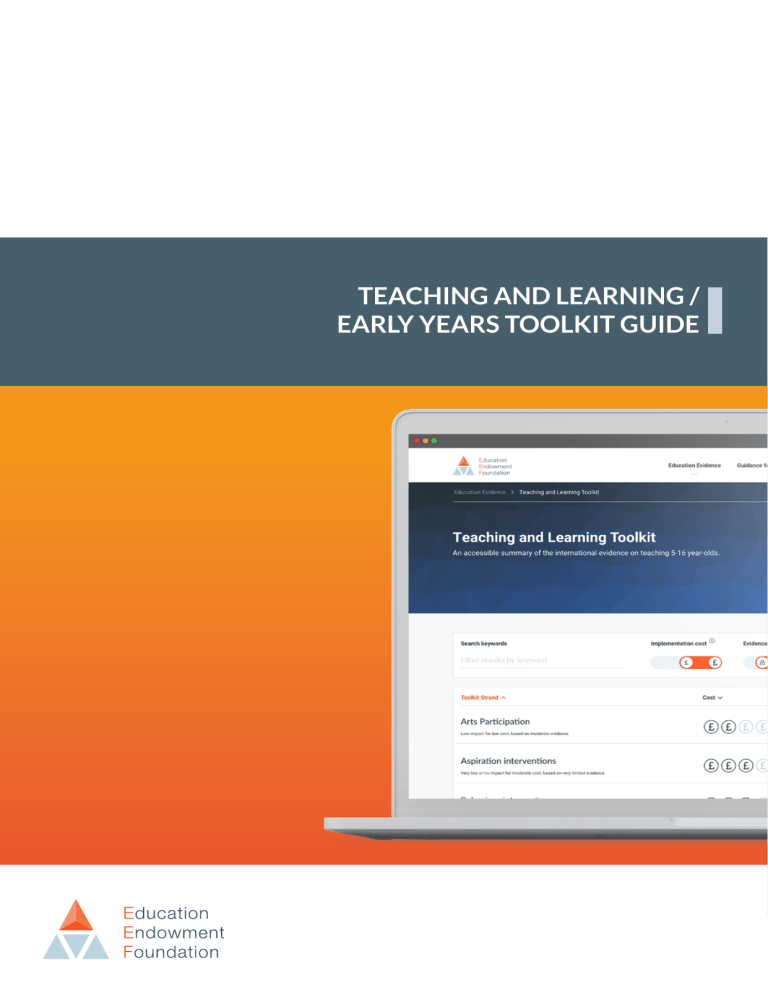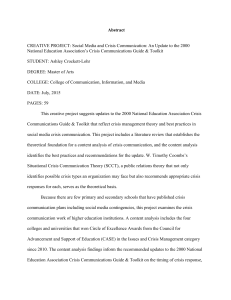Early Years Teaching Toolkit Guide: Evidence-Based Strategies
advertisement

TEACHING AND LEARNING / EARLY YEARS TOOLKIT GUIDE September 2021 About the Education Endowment Foundation The Education Endowment Foundation (EEF) is an independent charity supporting teachers and school leaders to use evidence of what works—and what doesn’t—to improve educational outcomes, especially for disadvantaged children and young people. Teaching and Learning / Early Years Toolkit guide 2 CONTENTS The Education Endowment Foundation Toolkit guide 1 Introducing the toolkits 4 2 Using the toolkits 5 - Top tips for getting the most out of the Toolkits 5 - Additional months' progress 6 - Evidence strength 7 - Cost 9 Teaching and Learning / Early Years Toolkit guide 3 INTRODUCING THE TOOLKITS Our Teaching and Learning Toolkit and its Early Years companion are accessible summaries of education research. The two Toolkits are designed to support teachers and school leaders who are making decisions about how to improve learning outcomes, particularly for disadvantaged children. Together, the Toolkits present over 40 approaches to improving teaching and learning, each summarised in terms of: • • • its average impact on attainment; the strength of the evidence supporting it; and its cost. The Toolkits do not make definitive claims as to what will work to improve outcomes in a given school. Rather, they provide high quality information about what is likely to be beneficial based on existing evidence. Click here for more about how to use the Toolkits. Both Toolkits are live resources that are updated on a regular basis as new findings from high-quality research, including EEF-funded projects, become available. We welcome suggestions for new topics to be included in future updates of the Toolkits, as well as comments or questions. Please contact Jonathan Kay. Teaching and Learning / Early Years Toolkit guide 4 USING THE TOOLKITS The Toolkits are designed to support teachers and school leaders who are making decisions about how to improve learning outcomes. The findings they present are based on real life data about what has happened when particular approaches have been used in schools before. The strength of the evidence also matters. Homework in secondary school is estimated to deliver 5 months’ additional progress. However, the evidence strength is very low and means that this estimate may be less reliable than topics in the Toolkit with more extensive evidence. Because the Toolkits do not provide definitive answers, they should not be used in isolation. Your professional judgement and expertise is also needed to move from the information in the Toolkit to an evidence-informed decision about what will work best in your school. 3. Draw on your professional expertise. Top tips for getting the most out of the Toolkits For example, parental engagement approaches have had an average impact of 3 additional months’ progress. However, the evidence suggests that it can be difficult to get parents involved in new programmes in the first place. So specific knowledge of your school community needs to be factored in before you can decide whether a particular parental engagement approach would be feasible. 1. Look beyond the headlines. Every approach in the Toolkit has a dedicated page which describes in more detail what it is, what it costs and what impact you can expect. This extra detail can really matter. Each strand also contains a section called ‘Behind the Average’, which gives more information on the different impacts of approaches for different ages or subjects. For some strands, like Teaching Assistants, there is substantial variation between the impact of everyday classroom use and trained teaching assistants delivering targeted interventions. 2. Think about cost and evidence as well as impact. The approaches with the largest impacts do not always provide the best value for money. For example, reducing class size has been shown to have a positive impact on pupil progress, on average (2 additional months’ progress), but because it requires new teachers it is expensive. Other approaches have had the same impact at a lower cost. The Toolkit can tell you whether an approach has a good track record, but your professional expertise and insight into your school’s specific context are also important in making well-informed decisions for your pupils. Systematically summarising evidence in the Toolkits The Teaching and Learning Toolkit pulls together a large amount of academic evidence that would otherwise sit behind academic paywalls. To avoid just selecting the positive or wellknown studies, the Toolkit uses a methodology known as systematic review. This means that the criteria for being included in the Toolkit is specified in advance. Any study that meets the criteria is included. Studies cannot be excluded to increase or decrease the impact or because researchers do not like the results. Teaching and Learning / Early Years Toolkit guide 5 USING THE TOOLKITS Additional months' progress The impact measure shows the number of additional months of progress made, on average, by children and young people who received the intervention, compared to similar children and young people who did not. This means that pupils in the classes where feedback interventions were provided made, on average, 6 months' more progress than similar pupils in other classes. For example, the 'Feedback' strand shows that in the research studies included in the Toolkit, improving the quality of feedback had an average impact of 6 additional months’ progress. The months of additional progress estimates are based on ‘effect sizes’ reported in British and international research studies. Feedback +6 Very high impact for very low cost based on moderate evidence Effect sizes describe the size of the difference between two groups in a standard and comparable way. However, it can be difficult to understand what a given effect size actually means for the progress of children and young people. That is why the EEF translates effect sizes into the months’ progress measure, as shown in the table below. Months' progress Effect size from... to... Description 0 -0.05 0.05 Very low or no impact +1 0.06 0.09 Low impact +2 0.10 0.18 Low impact +3 0.19 0.26 Moderate impact +4 0.27 0.35 Moderate impact +5 0.36 0.44 High impact +6 0.45 0.52 Very high impact +7 0.53 0.61 Very high impact +8 0.62 0.69 Very high impact +9 0.70 0.78 Very high impact +10 0.79 0.87 Very high impact +11 0.88 0.95 Very high impact +12 0.96 1.00 Very high impact Teaching and Learning / Early Years Toolkit guide 6 USING THE TOOLKITS Evidence strength The EEF 'padlock' rating The initial padlock ratings are: The Toolkit presents a rating of the security of the evidence for each approach. This is illustrated on the Toolkit website using a padlock icon so it is sometimes referred to as the 'padlock' rating. This rating provides an overall estimate of the robustness of the evidence, to help support professional decisionmaking in schools. Topics are awarded padlocks based on the number of studies that meet the Toolkit inclusion criteria. Additional padlocks are then lost due to a number of potential threats to security. Studies included in the Toolkit all take place in schools rather than lab-studies, involve a comparison group (rather than simply testing pupils before and after intervention), and meet the definition of each topic. = Very limited evidence: At least 10 studies that meet the Toolkit inclusion criteria. = Limited evidence: Between 11 and 24 studies that meet Toolkit inclusion criteria. = Moderate evidence: Between 25 and 44 studies that meet Toolkit inclusion criteria. = Extensive evidence: Between 45 and 69 studies that meet Toolkit inclusion criteria. = Very Extensive evidence: 70 or more studies that meet Toolkit inclusion criteria. Where there are fewer than 10 studies that meet the inclusion criteria a 0 padlock security rating is awarded, and months’ progress are not communicated. Teaching and Learning / Early Years Toolkit guide 7 USING THE TOOLKITS Additional padlocks can be lost because: • Only a small percentage of the studies have taken place recently. This might mean that the research is not representative of current practice. • A large percentage of the studies included are not randomised controlled trials. While other study designs still give important information about effectiveness of approaches, there is a risk that results are influenced by unknown factors that are not part of the intervention. • A large percentage of the studies took place in conditions distinct from regular school practice. While all studies included in the Toolkit take place in real classrooms (as opposed to “lab studies”), studies that are delivered by researchers rather than teachers tell us less about how an approach will be implemented. • A large percentage of the studies were not independently evaluated. Evaluations conducted by organisations connected with the approach – for example, commercial providers, typically have larger impacts, which may influence the overall impact of the strand. • There is a large amount of unexplained variation between the results included in the topic. All reviews contain some variation in results, which is why it is important to look behind the average. Unexplained variation (or heterogeneity) reduces our certainty in the results in ways that we have been unable to test by looking at how context, methodology or approach is influencing impact. Teaching and Learning / Early Years Toolkit guide 8 USING THE TOOLKITS Cost The cost estimates in the Toolkits are based on the average cost of delivering the intervention. Each strand also discusses the range of potential costs— for example, many interventions are more expensive when professional development costs are added to ensure high quality delivery. are expected to already have, such as interactive whiteboards, or teachers (unless an additional teacher is necessary to deliver the approach). This is because we think additional expenditure is the most useful figure to present to school leaders who are deciding how to allocate budgets. Cost estimates can include: Presenting the cost for each Toolkit strand allows schools to consider the cost-effectiveness of different approaches, as well as their impact. For example, One to one tuition and Peer tutoring both deliver 5 months of additional progress on average. However, one to one tuition is considerably more expensive on average. • the cost of new resources, such as IT hardware or software; • the cost of training courses or professional development to support a new approach, and teacher cover to enable this to happen; • The cost ratings are based on a 5-point scale as shown below: the cost of activities for pupils such as outdoor education programmes or music tuition. Cost estimates do not cover resources which are required to deliver the approach and which schools Cost estimate For more detail on how the cost estimates are developed see the Toolkit Manual. Description Cost details Very low up to £2,000 per year per class of 25 pupils, or less than £80 per pupil per year Low £2,001 to £5,000 per year per class of 25 pupils, or up to £200 per pupil per year Moderate £5,001 to £18,000 per year per class of 25 pupils, or up to £720 per pupil per year High £18,001 to £30,000 per year per class of 25 pupils, or up to £1,200 per pupil Very high over £30,000 per year per class of 25 pupils, or over £1,200 per pupil Teaching and Learning / Early Years Toolkit guide 9 Production and artwork by Percipio https://percipio.london Education Endowment Foundation 5th Floor, Millbank Tower 21–24 Millbank London SW1P 4QP www.educationendowmentfoundation.org.uk @EducEndowFoundn Facebook.com/EducEndowFoundn


